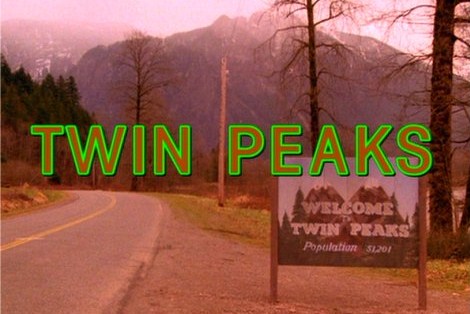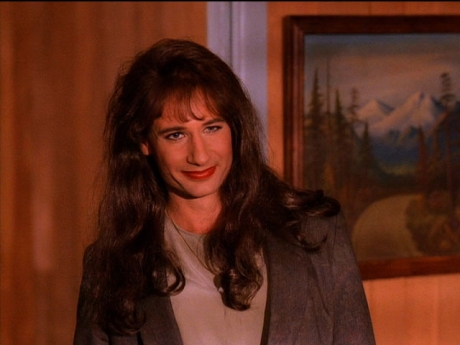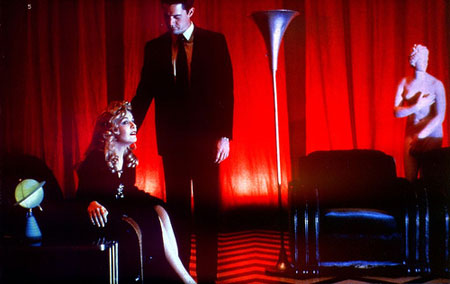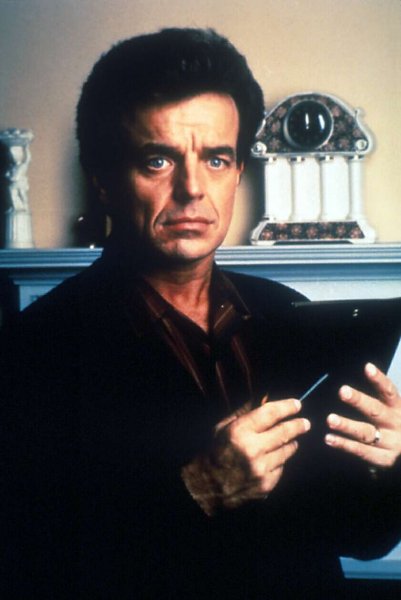
Since we’re wrapping up X-tober I wanted to take a look back at Twin Peaks, one of the biggest influences on The X-Files. The similarities between Twin Peaks and The X-Files are easy to spot. Both shows featured a stoic and eccentric FBI agent trying to uncover mysteries that most people can’t and don’t want to understand. The best episodes of both shows were the ones that created more mysteries than they revealed. And, of course, there’s David Duchovny’s infamous three episode appearance on Peaks as transgendered DEA Agent Denise Bryson.

Twin Peaks is too complicated to be summed up in one post. So, instead I want to focus on one aspect of the show—one thing Peaks did differently and better than most other shows or films. This is difficult because Twin Peaks did everything differently, which is why the show still feels fresh. Short of some crimped hair, sorry Shelly, the show has barely aged.
I’m not going to include any spoilers, but it all begins with the discovery of Laura Palmer’s body. Laura was the pretty, blonde, popular homecoming queen who seemed to represent all that was good about the town of Twin Peaks. FBI Agent Dale Cooper comes to town to find her killer and discover if her death is related to other murders. Cooper finds a town riddled with mysteries, lies, and darkness. The basic plot set-up is similar to tons of other TV shows and films—The Killing is only one of the most recent examples.
But while The Killing went for ultra-realism, Twin Peaks aimed for something much stranger. David Lynch and Mark Frost didn’t try to create a realistic world. There are ladies who talk to logs, a mysterious man with one arm, dream sequences complete with a dancing Michael J. Anderson, materializing giants, and also, well, demons. Even so-called “normal” settings are infused with menace.

Starting in the first episode, Laura’s house is one of the more bizarre and disturbing places we visit. I’ll examine different parts of the show in other posts, but here I want to talk about Laura’s parents.
Parent of murder victim is in the running for most frequent character of all time. And I don’t just mean on TV. Movies, books, plays, you name it, are all filled with parents dealing with the loss of a child. Sometimes these characters are walk-ons, like in every episode of all the Law & Orders ever. Or, like Jimmy Markum in Mystic River, the character’s struggle with grief is the central story.
We’ve seen this so many times that the reactions are pretty clear—shock, tears, anger (with more tears), then coming to some sort of (tearful) acceptance of the death. This can be handled well (cut to Sean Penn in the Mystic River film) or not so well (cut to nearly everything else), but the reactions are all pretty much variations of the same thing. Except for Twin Peaks.
Sarah and Leland Palmer are played by Grace Zabriskie and Ray Wise, and their performances take the role of grieving parents into uncharted territory. Sure there’s tears, shock, anger, and so on, but all that soon gives way to stranger, more unique reactions.

The guy totally loses it. But his mania, while funny, is also very disturbing. The viewer feels for Leland and understands how broken he is. This culminates in something so strange that I’m not going to discuss it—fans of the show know what I’m talking about, and everyone else should just start watching Twin Peaks tonight.

One of the goals of The Killing, in my opinion, was to re-write Twin Peaks in an ultra-realistic manner. The Killing borrows most of the plot from Peaks and even steals the “Who Killed Laura Palmer” tagline. But Sarah and Leland Palmer’s grief had a bigger impact on me than Mitch and Stan Larsen’s grim hysteria. Give me a man singing songs from “Oklahoma” over yet another crying parent on the bathroom floor.
I know that there’s something not entirely accurate about how Sarah and Leland Palmer react to their daughter’s death. People have to move on with their lives, they do accept tragedy, they cry and they still go to work. They act, or want to act, more like Stan and Mitch Larsen. But good art shouldn’t only be realistic or psychologically accurate. Good art, instead, should show us something new, something a little strange.
Richard Z. Santos lives outside of Austin and is enrolled in the MFA program at Texas State University. Once, he worked in Washington, DC, but now he doesn’t do much more than write and teach. He blogs at Paperclip People, and is working on his first novel—a crime thriller set in New Mexico.

I have mixed feelings about Twin Peaks, appreciating its flawed genius, but I was one of those who felt cheated during the second season dénouement. A friend recently gave me David Lynch’s works on DVD and I rewatched Twin Peaks again, somewhat more forgiving. It is unforgettable.
I hadn’t thought about it, but you’re absolutely right, Richard. Leland’s grief was so strange and unfathomable, but I never doubted it for a second. It was a facinating picture of the wreckage after a person is chopped out of the heart of a family, especially as she’s revealed to be the center of gravity for it, and in some ways, for the whole town. Eccentric orbit doesn’t begin to describe. . .
On a side note, I loved when Psych paid homage to it with tons of the original actors, including Sherilyn Fenn, and plenty of so-good pie.
Hi Leigh–yeah the second season is tough, but I really do think the final few episodes of that season pick up. But the show just completely lost its focus after solving Laura’s murder. Pretty painful…
Oh clare2e, I haven’t seen that episode of Psych–I should check that out!
Here’s more spoilery info about “Dual Spires,” episode 512, the [url=http://marquee.blogs.cnn.com/2010/12/02/psych-does-a-damn-fine-twin-peaks-tribute/]Psych tribute to Twin Peaks[/url], but don’t read it first if you want to hunt the references yourself. Keep count–this blogger found 28! It’s a can’t miss, and there may be another TP tribute in the works.
Inspirational thanks to both Richard and Clare for [url=http://www.sleuthsayers.org/2011/11/twin-peaks.html]SleuthSayers Sunday’s article[/url].